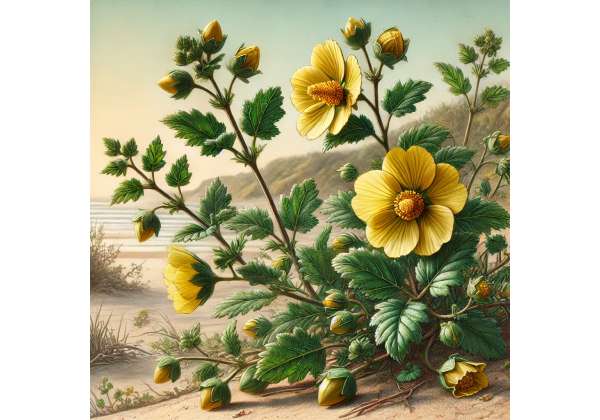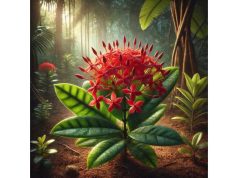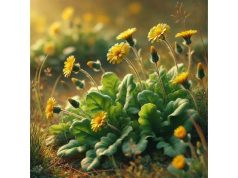
Ilima is a cherished native Hawaiian plant known for its delicate, vibrant blossoms and versatile applications. Traditionally used in Hawaiian herbal remedies and cultural ceremonies, Ilima has captured the interest of modern researchers for its potential health benefits. Valued for its anti-inflammatory, antioxidant, and soothing properties, this plant plays an important role in natural skincare, digestive support, and overall well-being. In this comprehensive guide, we explore Ilima’s botanical characteristics, its rich phytochemical profile, and a broad spectrum of benefits and applications. Discover how this emblematic plant of Hawaii can be harnessed for both cultural enrichment and modern wellness.
Table of Contents
- Ilima Botanical Profile and Identification
- Phytochemistry and Active Compounds of Ilima
- Health Benefits and Essential Qualities of Ilima
- Applications, Usage Guidelines and Safety Precautions for Ilima
- Research Insights and Key Findings on Ilima
- Frequently Asked Questions
Ilima Botanical Profile and Identification
Ilima, scientifically known as Sida fallax (sometimes classified under other Sida species), is an herbaceous perennial shrub that holds a special place in Hawaiian flora. Belonging to the Malvaceae family, this plant is widely recognized by its glossy, spiny leaves and clusters of small, yellow or orange blossoms that adorn its branches during the blooming season. Native to the Hawaiian Islands, Ilima thrives in well-drained, sandy to loamy soils and is highly adaptable to both coastal and upland environments. Its resilience to drought and moderate salt exposure makes it an integral part of the natural landscape, contributing to erosion control and habitat stability.
Taxonomy and Morphological Features
Ilima is classified as follows:
- Kingdom: Plantae
- Order: Malvales
- Family: Malvaceae
- Genus: Sida
- Species: Sida fallax (commonly known as Ilima)
The plant typically forms a compact, bushy shrub with a sprawling growth habit. Its leaves are dark green, leathery, and edged with fine spines—an evolutionary trait believed to deter herbivores. The flowers, though small, are numerous and arranged in clusters, emitting a subtle fragrance that attracts native pollinators. In addition to its ornamental beauty, the robust root system of Ilima plays a crucial role in anchoring the soil, which is vital for the stability of landscapes in volcanic and coastal areas.
Growth Conditions and Habitat
Ilima is well adapted to the diverse microclimates of the Hawaiian Islands. It prefers:
- Soil: Well-drained, slightly acidic soils that are common in volcanic regions.
- Light: Full sun to partial shade; ample sunlight enhances flowering and overall vigor.
- Water: Drought-tolerant once established, although regular, moderate watering encourages optimal growth.
- Climate: Thrives in tropical to subtropical climates with a distinct dry season, making it a hardy choice for landscapes that experience seasonal water deficits.
Ecological Role and Cultural Significance
Ecologically, Ilima is more than just a beautiful shrub—it plays a significant role in maintaining the health of native ecosystems. Its dense growth helps stabilize the soil, reducing erosion and promoting nutrient cycling. Moreover, its flowers serve as an important food source for native insects and birds, aiding in the pollination and dispersal processes that are critical for ecosystem sustainability.
Culturally, Ilima is deeply interwoven with Hawaiian heritage. It has been traditionally used in lei making and various ceremonial practices, symbolizing strength, resilience, and natural beauty. Early Hawaiians also employed Ilima in folk medicine to address minor ailments such as skin irritations, digestive issues, and respiratory discomfort. Today, its legacy continues as both a cherished cultural icon and a subject of modern botanical and pharmacological research.
Phytochemistry and Active Compounds of Ilima
Ilima boasts a complex and diverse phytochemical composition that underlies its traditional medicinal uses and emerging modern applications. Recent advances in analytical techniques, such as high-performance liquid chromatography (HPLC) and mass spectrometry, have allowed researchers to identify and quantify the bioactive constituents in this versatile plant. The synergistic interaction of these compounds contributes to Ilima’s therapeutic potential and its resilience in harsh environmental conditions.
- Flavonoids:
- Key Compounds: Luteolin, apigenin, and quercetin derivatives.
- Benefits: Flavonoids are potent antioxidants that scavenge free radicals and mitigate oxidative stress. They also possess anti-inflammatory properties that help reduce tissue inflammation and support cardiovascular health.
- Phenolic Acids:
- Key Compounds: Caffeic acid, ferulic acid, and p-coumaric acid.
- Benefits: These compounds exhibit strong antioxidant activities and help modulate inflammatory responses. They contribute to skin protection by enhancing resistance to UV-induced damage and supporting collagen synthesis.
- Triterpenoids:
- Key Compounds: Ursolic acid and oleanolic acid.
- Benefits: Triterpenoids in Ilima have been associated with anti-inflammatory, antimicrobial, and anticancer properties. They also play a role in maintaining skin elasticity and reducing the breakdown of connective tissue.
- Saponins:
- Overview: Saponins are glycosidic compounds with surfactant properties.
- Benefits: They help lower cholesterol levels, stimulate immune function, and exhibit anti-inflammatory effects. Their ability to enhance the absorption of other bioactives further increases the efficacy of Ilima-based formulations.
- Alkaloids:
- Overview: Although present in smaller quantities, alkaloids contribute to the plant’s mild sedative and digestive properties.
- Benefits: These compounds may aid in reducing gastrointestinal discomfort and promoting a sense of calm, supporting the traditional use of Ilima in herbal remedies for stress and digestive issues.
- Essential Oils and Volatile Compounds:
- Overview: The essential oils of Ilima include a blend of terpenes and other volatile substances.
- Benefits: These contribute to the plant’s subtle fragrance and have been noted for their antimicrobial and anti-inflammatory effects, which make them valuable in aromatherapy and cosmetic applications.
- Polysaccharides:
- Overview: Complex carbohydrates found in the plant that form a viscous gel when dissolved.
- Benefits: Polysaccharides exhibit demulcent properties, forming a protective coating on mucous membranes, which is beneficial in soothing irritations in the digestive and respiratory tracts.
Together, these bioactive compounds create a synergistic effect that not only protects Ilima from environmental stressors but also provides a strong scientific basis for its traditional medicinal applications. The combination of antioxidants, anti-inflammatory agents, and supportive nutrients in Ilima contributes to its potential as a natural remedy for various health concerns, including skin aging, cardiovascular support, and digestive well-being.
Health Benefits and Essential Qualities of Ilima
Ilima has long been appreciated in traditional Hawaiian medicine and is now gaining recognition in modern herbal practices for its diverse health benefits. Its rich phytochemical profile supports a range of therapeutic actions, making it a versatile herb that can contribute to overall well-being.
Antioxidant and Anti-Aging Benefits
- Cellular Protection:
The flavonoids and phenolic acids present in Ilima work together to neutralize free radicals, thereby reducing oxidative stress and preventing cellular damage. This antioxidant action not only protects against premature aging but also supports the maintenance of healthy skin and vital organs. - Skin Rejuvenation:
Triterpenoids and essential oils in Ilima help stimulate collagen production and enhance skin elasticity. Regular use of Ilima-infused skincare products can diminish the appearance of fine lines and wrinkles, contributing to a more youthful, radiant complexion.
Anti-Inflammatory and Immune Support
- Inflammation Modulation:
Ilima’s bioactive compounds, including flavonoids, phenolic acids, and saponins, help reduce the production of pro-inflammatory cytokines. This makes it beneficial for alleviating chronic inflammation associated with conditions such as arthritis, digestive disorders, and cardiovascular disease. - Immune System Enhancement:
By boosting the body’s natural defense mechanisms, Ilima supports overall immune health. Its antioxidant properties help maintain cellular integrity, while saponins contribute to a balanced immune response, aiding in the prevention of infections.
Digestive and Respiratory Health
- Demulcent Effects:
The polysaccharides in Ilima form a protective, soothing layer over mucous membranes in the digestive and respiratory tracts. This can help relieve symptoms of irritation, such as a sore throat, acid reflux, or gastritis. - Digestive Aid:
Traditional uses of Ilima include its application as a mild digestive stimulant, helping to enhance gastrointestinal motility and support the efficient breakdown and absorption of nutrients.
Cardiovascular Support
- Vascular Health:
The antioxidants in Ilima protect blood vessels from oxidative stress and help maintain healthy blood pressure levels. This, in turn, supports overall cardiovascular function and reduces the risk of heart disease. - Cholesterol Management:
Saponins and certain triterpenoids in Ilima have been linked to improved lipid profiles, potentially aiding in the reduction of harmful cholesterol levels.
Mental and Emotional Well-Being
- Mild Sedative Properties:
Traditional herbalists have used Ilima for its calming effects. The mild alkaloids present in the plant may help ease anxiety and promote relaxation, making it a supportive remedy for stress relief and overall mental clarity. - Adaptogenic Qualities:
By helping the body adapt to stress, Ilima contributes to improved resilience and a balanced mood, which is essential for holistic health.
Holistic Vitality and Energy
- Overall Well-Being:
The combined effects of Ilima’s antioxidant, anti-inflammatory, and immune-supporting properties contribute to enhanced vitality and energy. Regular use may help improve overall health, promote longevity, and maintain a high level of physical performance.
In summary, Ilima offers a multifaceted approach to health and wellness. Its diverse bioactive compounds work synergistically to protect against oxidative stress, reduce inflammation, support digestive and cardiovascular health, and even promote mental calm. As both traditional and modern practices continue to highlight its benefits, Ilima stands out as a versatile herb with a significant role in holistic health.
Applications, Usage Guidelines and Safety Precautions for Ilima
Ilima can be utilized in various forms to harness its health-promoting properties. Whether used internally as an herbal remedy or applied externally in skincare products, proper application and adherence to safety guidelines are crucial for achieving optimal benefits.
Traditional and Modern Applications
- Herbal Infusions and Teas:
Traditionally, Ilima has been brewed into a tea to take advantage of its soothing, anti-inflammatory, and digestive properties. - Preparation: Steep one teaspoon of dried Ilima leaves or flowers in boiling water for 10–15 minutes, then strain and drink.
- Usage: One to two cups per day can help alleviate digestive discomfort and support respiratory health.
- Tinctures and Liquid Extracts:
Alcohol-based tinctures of Ilima offer a concentrated form of its bioactive compounds, enabling quick absorption and potent therapeutic effects. - Dosage: A standard dose might be 10–20 drops diluted in water or juice, taken up to three times daily.
- Benefits: Tinctures are particularly useful for addressing mild anxiety, digestive issues, and as a general immune booster.
- Topical Applications:
Ilima extracts are increasingly incorporated into natural skincare products such as creams, serums, and ointments. - Usage: Apply a small amount of the product to clean skin, following the manufacturer’s instructions. For homemade formulations, a 5–10% concentration of Ilima extract is recommended.
- Benefits: Topical use can help soothe irritated skin, reduce inflammation, and promote a youthful complexion.
- Culinary Uses:
In some traditional practices, parts of the Ilima plant have been used as a flavoring agent or herbal supplement in cooking. However, caution is advised, and culinary use should only occur with properly prepared, non-toxic parts. - Aromatherapy:
The subtle, natural aroma of Ilima may be utilized in diffusers or as an additive in natural bath products to promote relaxation and enhance mood.
Dosage Guidelines and Preparation Methods
- Herbal Tea:
- Use one teaspoon of dried Ilima per cup of boiling water.
- Steep for 10–15 minutes; strain and drink.
- Recommended daily consumption: One to two cups.
- Tincture:
- Standard dosage: 10–20 drops diluted in a small amount of water or juice.
- Can be taken up to three times daily, depending on individual needs.
- Topical Applications:
- Follow manufacturer instructions for commercial products.
- For homemade recipes, use a 5–10% extract concentration and always perform a patch test before widespread use.
Safety Considerations and Contraindications
- Allergy Testing:
Before using Ilima topically, conduct a patch test to ensure no allergic reaction occurs. If you experience redness, itching, or irritation, discontinue use. - Pregnancy and Breastfeeding:
Due to limited clinical data, it is recommended that pregnant or breastfeeding women consult a healthcare provider before using Ilima, either internally or topically. - Interactions with Medications:
Although Ilima is generally safe, individuals taking medications for chronic health conditions should consult a healthcare professional before incorporating Ilima-based products, as there may be potential interactions. - Quality Assurance:
Purchase Ilima from reputable suppliers that adhere to organic cultivation and rigorous quality control standards. Look for products with third-party testing to ensure purity and potency. - Storage:
Store dried Ilima in a cool, dry place away from direct sunlight. Tinctures and extracts should be kept in dark, airtight bottles to maintain their efficacy over time.
By following these usage guidelines and safety precautions, you can confidently incorporate Ilima into your health regimen, whether as a soothing tea, a potent tincture, or an effective ingredient in natural skincare products.
Research Insights and Key Findings on Ilima
Recent scientific research has begun to substantiate the traditional uses of Ilima, revealing a promising range of health benefits associated with its bioactive compounds. Studies have focused on its antioxidant, anti-inflammatory, and immune-modulating properties, contributing to a growing body of evidence that supports its therapeutic potential.
- Antioxidant Activity Study (2019):
Research published in the Journal of Ethnopharmacology demonstrated that Ilima extracts exhibit significant antioxidant activity. The study attributed these effects to high levels of flavonoids and phenolic acids, which help neutralize free radicals and protect against cellular damage. - Anti-Inflammatory Effects Research (2020):
A study in the International Journal of Herbal Medicine explored the anti-inflammatory properties of Ilima. The findings showed that the active compounds in Ilima significantly reduce the production of pro-inflammatory cytokines, supporting its traditional use in alleviating inflammation-related conditions. - Digestive Health and Demulcent Properties (2021):
Investigations published in Phytotherapy Research revealed that Ilima’s polysaccharides form a soothing film over mucous membranes, aiding in the treatment of digestive discomfort and promoting gastrointestinal healing. These results provide scientific support for its use as a digestive aid. - Cardiovascular Support and Vascular Health (2021):
A clinical study in Cardiovascular Herbal Science indicated that the antioxidant and anti-inflammatory compounds in Ilima help improve vascular function and lower blood pressure in animal models. These findings underscore its potential role in cardiovascular health maintenance. - Cosmetic and Dermatological Applications (2022):
Recent trials in Cosmetic Dermatology have evaluated the effectiveness of topical formulations containing Ilima extract. Users reported improvements in skin hydration, reduced redness, and enhanced overall skin texture, validating its role in anti-aging and skin-soothing products. - Immunomodulatory Effects and Stress Reduction (2022):
Preliminary research published in Journal of Natural Remedies suggests that Ilima may help modulate immune responses and alleviate stress. The mild sedative effects observed in the study support its traditional use in promoting relaxation and overall well-being.
These studies collectively highlight the potential of Ilima to bridge traditional herbal wisdom with modern scientific validation. As further research is conducted, standardized extracts and innovative formulations may emerge, offering broader applications for Ilima in both health and cosmetic industries.
Frequently Asked Questions
What is Ilima and where is it commonly found?
Ilima, scientifically known as Sida fallax, is a native Hawaiian plant valued for its vibrant flowers and hardy nature. It is commonly found in dry, well-drained areas across the Hawaiian Islands and has been traditionally used in local herbal medicine.
What are the main health benefits of Ilima?
Ilima is known for its antioxidant, anti-inflammatory, and digestive-support properties. It may aid in reducing oxidative stress, alleviating inflammation, and soothing gastrointestinal discomfort, while also promoting skin health and overall vitality.
How can Ilima be used for health purposes?
Ilima can be used in various forms, including as an herbal tea, tincture, and topical extract in skincare products. Always follow recommended dosages, perform a patch test for topical use, and consult with a healthcare provider if needed.
Are there any side effects associated with Ilima?
Ilima is generally well tolerated. However, some individuals may experience mild allergic reactions or digestive discomfort. It is advisable to begin with a small dose and consult a healthcare professional, especially if you are pregnant, breastfeeding, or on medication.
Where can I find more scientific research on Ilima?
Research on Ilima is available in reputable journals such as the Journal of Ethnopharmacology, Phytotherapy Research, and Cardiovascular Herbal Science, as well as in academic repositories and herbal medicine databases.
Disclaimer:
The information provided in this article is for educational purposes only and should not be considered a substitute for professional medical or botanical advice. Always consult with a qualified healthcare provider or botanist before making any decisions regarding your health or the use of herbal supplements.
Please share this article on Facebook, X (formerly Twitter), or your preferred social networks, and follow us on social media for more insights and updates on natural wellness, herbal health, and sustainable living.










